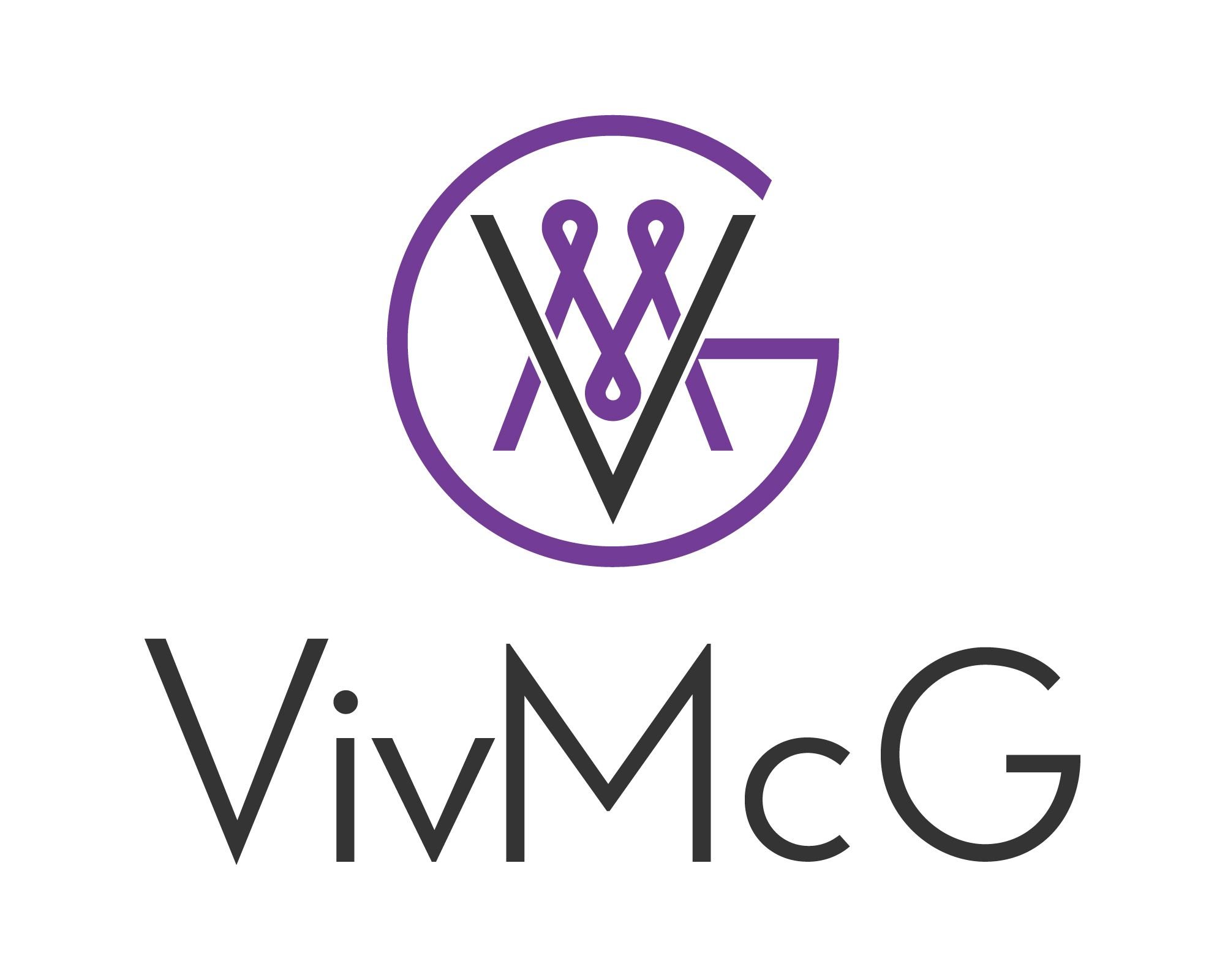start monday with gratitude
week 30
Welcome to Week 30, lovely soul.
Below you'll find the video and video transcript introducing you to this week's quote and musings.
Scroll further and you'll discover this week's daily exercises, high vibe tune, and downloadable wallpapers.
video transcript
You know what it’s like to stub your toe, right? Honestly, is there anything more painful? It’s absolutely crippling! And certainly not something you want to go around doing every day. So, I truly ‘get’ and appreciate Goodrich’s spin on what is a very small action that attracts truly painful consequences.
Here’s the thing. We take our health for granted. We take our bodies for granted. Until something goes wrong. Until we fall ill or develop a disease. And that’s when we stop and realise just how much our bodies do for us every single day, and what a difference it makes to be and feel healthy.
What I also see, however, are people who fall ill, recover (or their disease goes into remission) and they’re right back where they started, taking their body and health for granted. Hands up… I did exactly that myself, in the past, too!
While we’re ill we make all these promises that “never again will I take my health or body for granted” and, yet, as soon as we feel healthy, we forget our promises and fall back into life as usual. In essence we’ve lied to ourselves because it turned out it was easier to lie and return to the easy life of taking our life for granted than to keep our promise and, every single day, appreciate our body, our health and our life.
Most humans are, by nature, lazy. It’s a fact. And it’s easier to go back to a way of life that is comfortable and familiar, than to follow a path that, initially, takes effort; a path where you don’t take one more day for granted, one more breath for granted. Where you celebrate your life and your body every single day.
When you take your life, your body, your health for granted and do not show appreciation for what you already have, inevitably you’re going to lose what you have in some way or other. And when you do, all you experience is the endless numbing pain of regret. Perhaps that’s when you’ll understand that the occasional stub of your toe and the short-lived pain that followed, would have been, by far, the better option, when compared to long-lived numbing pain of regret.
However, when you take your life, your body, your health with gratitude and show appreciation for the strong body you have, for your health and for the vitality of life, every day, you’ll attract similar high vibrational energy into your life. Your health will stay strong, and your body will continue to bless you in achieving the small and large steps along life. And when the time comes when your body grows weaker, naturally, when you can’t do all the things you used to be able to do when you were younger, will you also experience regret just like you would have when you took your body and health for granted? Absolutely not. Because while life was coursing through your veins you appreciated it, you gave thanks for it, and you lived your best life every single day. And when you live your life with gratitude and appreciation, making the most of every single day, then there is no room for regret.
So, I invite you to make a promise to yourself today. I invite you to express gratitude for your body, for your health, for your life every single day. To spend each day living life to the full, relishing every breath. Let’s be real, here, it won’t be easy, at first, living life gratefully. At first, it’ll take some effort because you need to change the old comfortable habits that led you to live a life that was taken for granted. And you will fall off the bandwagon at times.
But here’s what’s so special. If you start today to appreciate and give thanks for your life, you’ve taken that first important step. And when you fall off the bandwagon once in a while (and we all do), you’ll find that you have more enthusiasm, more energy and more vitality coursing through your veins that you’ll want to (and be able to) run after that bandwagon and leap back on because you’ll have had a taste of just how great life can be when you live it gratefully.
So next time you stub your toe and experience the indescribable pain that runs through every inch of your body, take a deep breath and say “thank you God for reminding me for the miraculous body attached to my toe.” Because short-lived pain is much more bearable than the numbness of long-lived regret.
daily gratitude practice
monday
Very few people go through life with no regrets.
Regrets tend to arise when we have taken something for granted and then lose it. After it’s gone, regret reminds us that we didn’t make the most of its presence when it was here.
Can you think of such a regret in your life? It might be regret for an opportunity that you lost, a person in your life who has since passed on, an item that you lost.
Today you’re going to rub out regrets by spending time focusing on that opportunity, person or thing and remembering how much it brought to your life when it was present, no matter how long or short a period of time it was present.
Spend time now expressing gratitude for it, understanding how blessed your life was as a result of it. And let your feeling of gratitude slowly and gradually rub away and remove your feeling of regret.
tuesday
This week’s musings focused on how much we take our body and our health for granted, when we should actually express gratitude for it every day. So this week we’re going to change our perspective about our body and health so expressing gratitude becomes easier and more natural.
Today I invite you to focus on and observe your hands.
Throughout the day see how much you work with and use your hands.
Would you be able to do all that you do with your hands if you had no hands? Sure, you would eventually adapt but that would take a long time and, even then, would you really be as proficient without hands as you are with them?
When you focus and observe everything your hands do for you each day, does it give you a greater sense of appreciation for them?
Do you feel more grateful for your hands by the end of the day after you’ve witnessed just how much they do for you and just how hard they work for you?
wednesday
Whilst we tend to take our hands for granted all too often, it is easy, when you followed yesterday’s exercise, to appreciate just how much our hands do for us every day. And, as a result, it is easy to express gratitude for our hands.
But what about drilling down further?
What about your thumb? Do you have any appreciation of the importance of your thumb? Do you realise how much work your thumb does each day? Do you understand just how helpful it is to have a working thumb?
Because the thumb works so closely with the fingers and the hand, repeating yesterday’s exercise may not give you a full appreciation of your thumb.
So, today, for only 30 minutes or so, I invite you wrap a bandage or a piece of material around each of your hands in such a way that your thumbs, and only your thumbs, are wrapped away, pressed against the palms of your hand.
In this way you are, effectively, thumbless.
In the 30 minutes that your thumbs are out of commission, I invite you to perform every day simple tasks. Tasks like pouring yourself a drink, eating, cleaning your teeth, making the bed, getting money out of your purse or wallet, reading a book. Just simple everyday tasks.
How much more difficult are these tasks when you are thumbless? How much more awkward and challenging do these simple tasks become when you can’t use your thumbs? Do you have more respect for your thumbs as a result? Are you more grateful for your thumbs?
thursday
Today you’ll need a helper, someone you can trust to keep you safe.
Tie a scarf or piece of material around your head, covering your eyes. Make sure you can’t see through the scarf or material.
The aim is to fully remove your sight.
Then with the help of your volunteer, see how well you can navigate your way around your home.
Try to walk on you own, unaided. Your volunteer is simply there to ensure you don’t hurt yourself or trip over anything. However, you do not want them to be guiding you.
Please ensure you do not try this anywhere near stairs that you could fall down.
After this, perform a simple everyday task such as pouring yourself a drink of water (cold water and, perhaps, if you can, use a plastic cup of sorts) or making the bed or even peeling an orange.
Does it surprise you just how reliant you are on your eyes, on your ability to see? Are you more grateful for your ability to see as a result of this exercise?
friday
Have you ever noticed or experienced how much easier it is for people to offer support, help and even empathy for someone who is in some way physically ill on the outside compared to someone who is physically ill on the inside? For example, someone who has a broken leg versus someone who is diabetic?
It’s easier for us to relate to things we can physically see, something external, and harder for us to connect with and relate to things that are unseen, internal. And yet a person with a diabetes may be suffering as much or even more than someone with a broken leg.
It’s exactly the same when we consider ourselves and our own body. It’s easier to gain an appreciation for the things that we can easily see and experience, the outward things, than it is to appreciate and truly express gratitude for the inward and internal things.
Today (and tomorrow) we’re going to gain a better appreciation for the internal workings of our body so we can gain a greater appreciation for just how hard they work.
Our body operates using both voluntary and involuntary actions. A voluntary action is, for example, when you hold a toothbrush in your hand. And involuntary action is, for example, breathing.
An involuntary action tends to be an action the body needs to take to keep us alive. Quite frankly, if involuntary actions, such as breathing, were voluntary not many of us would live for very long.
And yet it’s these very actions, life-giving actions performed by our body, that we take most for granted.
To encourage you to gain a greater appreciation of your body and the involuntary actions it performs, we’re going to purposely interrupt and stop the involuntary act of breathing.
I invite you to hold your breath, to stop breathing for 5 minutes. Can you do that? Of course you can’t!
Most people can only hold their breath for a maximum of 90 seconds and then the body’s reflexes kick in to save you and forces you to breathe.
So, hold your breath for as long as you can, up to 2 minutes maximum. And notice everything that happens in your body when you do.
Do you feel pressure anywhere? Do you see dots in front of your eyes? Do you feel dizzy? Notice everything that happens as your body fights to survive without oxygen.
And then when you take your next breath, how does that feel? How does you body feel getting oxygen back into it?
Do you think you could hold your breath for 2 minutes, gulp one breath and go back to holding your breath for 2 minutes, and do this for an hour? It’s highly unlikely. There’s a chance, for example, that you might faint.
When you think of how efficiently, how effectively, how easily your body naturally breathes without any input from you and that it does this every second of every single hour of every day, do you have a little more appreciation, admiration and gratitude for your wonderful body?
saturday
How in tune are you with your body? How sensitive are you to changes in your body? Let’s see.
Today we’re going to focus on and express gratitude for our digestive system.
Again, it’s an internal system and, so, it often escapes our attention, until something goes wrong. However, today we’re going to tune into it as closely as possible.
You’ll need some food for this exercise today. Anything will work.
First bite into the food. How easy is it to bite the food with your teeth? How strong are your teeth that they can bite into any food?
And then focus on the feeling of the food in your mouth. Focus on the taste too. Where are you tasting the food in your mouth? Can you pinpoint the area where you taste the food?
And what about the composition of the food as you chew it into smaller pieces so it can travel through your digestive system without becoming blocked or hurting you. How does it feel to chew the food? Do you notice saliva appearing in your mouth?
Now comes the harder part. Swallow that piece of food and feel, for as long as you can, as it travels through your digestive system. How far can you follow it on its travels? Down your throat? Along the oesophagus? Into the stomach? How far can you track the food you’ve just swallowed?
The more you practise this exercise, the further you may be able to track your food.
However, at some stage, the food just ‘disappears’ along its digestive journey; you no longer can feel or sense it. However, that doesn’t mean the food has just vanished. Your body is still working hard to process this food, to extract all the nutrients, minerals and goodness from the food and extricate what’s left from your body.
Think of the full process that your body goes through for every single thing you eat. Consider the parts of the process where you participate such as the biting, chewing and swallowing. And the parts that are happening inside you without your conscious awareness, such as when the stomach releases acid to kill any germs and breaks the food down further, when the small intestine separates the part of the food it can use, that is beneficial to your body, and then sends these round your body via the bloodstream, when the large intestine extracts water from the food for your body to use, and then ‘dumps’ (for want of a better word) the waste that doesn’t serve your body.
Can you imagine how difficult it would be to build a machine that could do what your body does so effortlessly? Does this give you greater appreciation for the internal workings of your digestive system, just one of your internal operating systems that keep you alive?
sunday
Our bodies are much more intelligent than we often give them credit for.
Usually, when we temporarily lose our health, for example through spraining an ankle, it’s actually our body warning us that something’s out of balance, for example, we’re doing too much and trying to run through life too fast.
When we heed our body’s cry and are (forced) to slow down, it wondrously heals itself. But if we don’t listen to our body’s initial warnings, then our body can become weak and a more permanent imbalance or illness may set in.
Can you think of a time when you fell ill. It might have been through catching a cold, stubbing your toe, burning your finger, fainting. Think of something that you quickly recovered from and, preferably, something recent.
Think back to your life before this illness happened.
Can you connect the illness with how you were living your life prior to it stopping you in your tracks? Can you see that the illness was a warning sign from your body? Do you have a new-found or greater appreciation for the intelligence of your body as a result of seeing this connection?
Now you understand the warning messages your body may give you, will you heed them in future, find the connection and correct your life so your body can become strong again so you can, hopefully, avoid more serious consequences? Are you grateful for your intelligent body?
and let's not forget...

This week's high vibe tune reminds you not to let a stubbed toe get in the way of dancing foot-loose and fancy-free
have gratitude wherever you go...
... with this week's gratitude quote wallpaper.
Note: details of how to download this week's wallpaper is provided below.
“Every once in a while, God allows you to stub your toe as a kind reminder to be grateful for the miraculous body attached to it” ~ Richelle E Goodrich
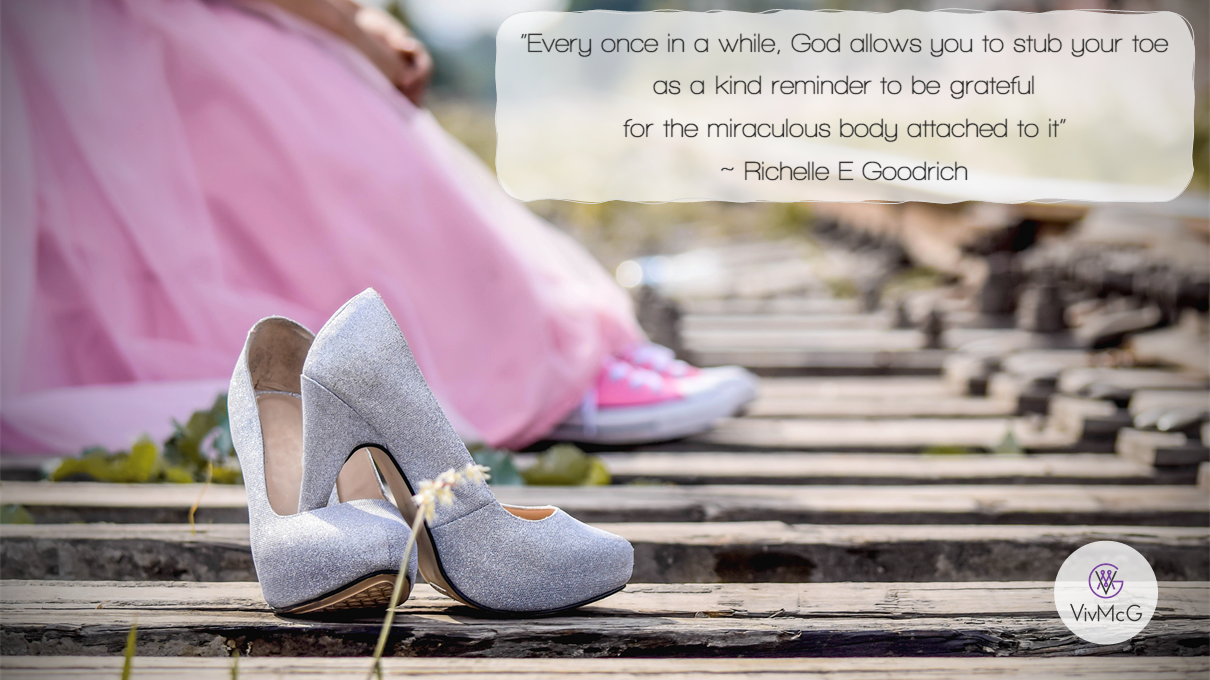
16:9
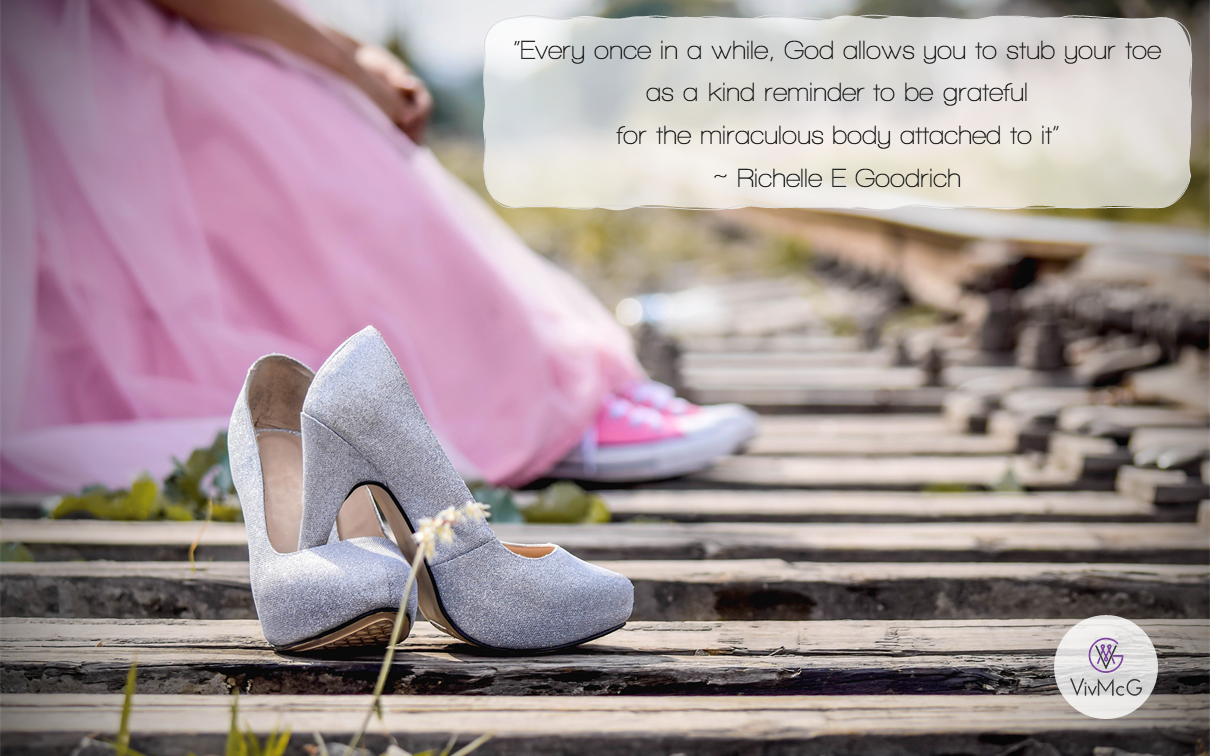
16:10
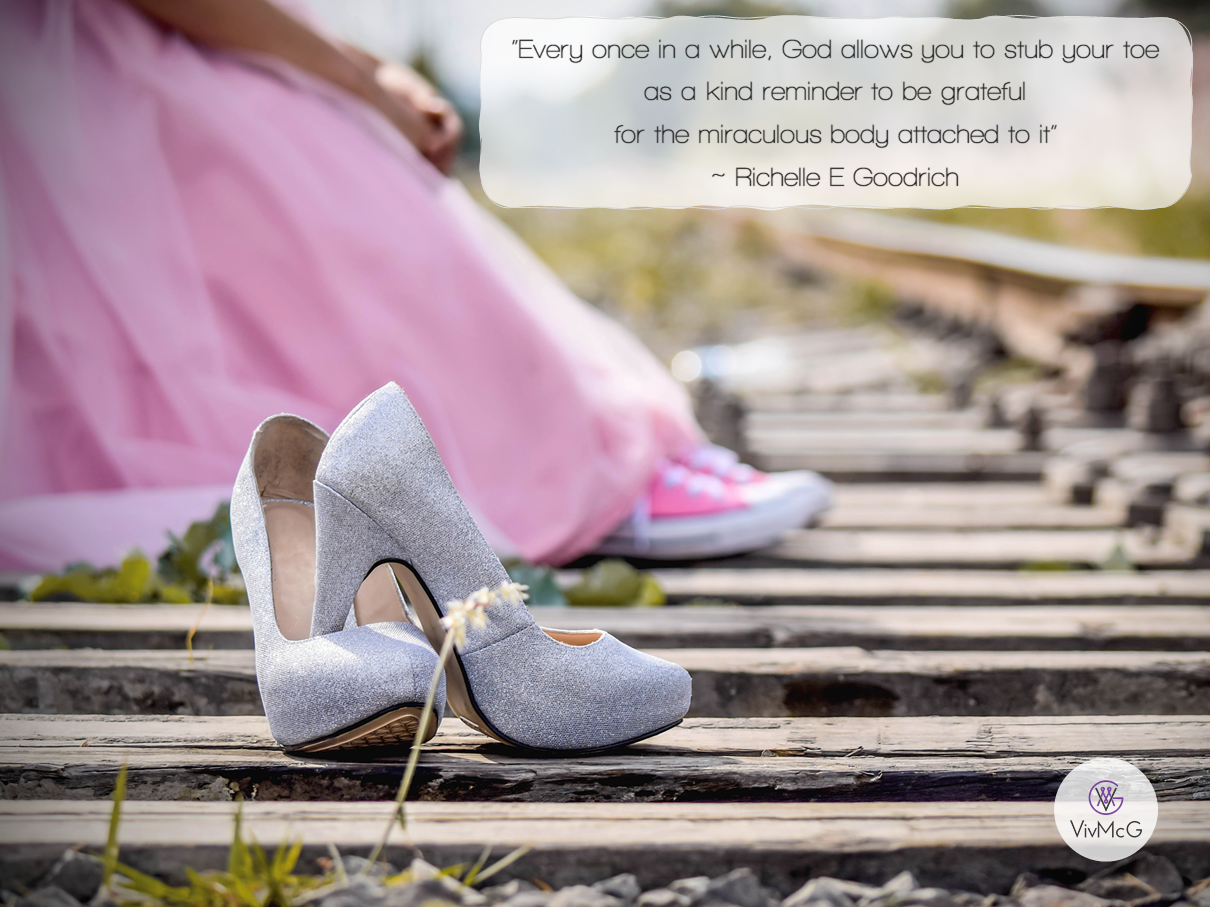
4:3
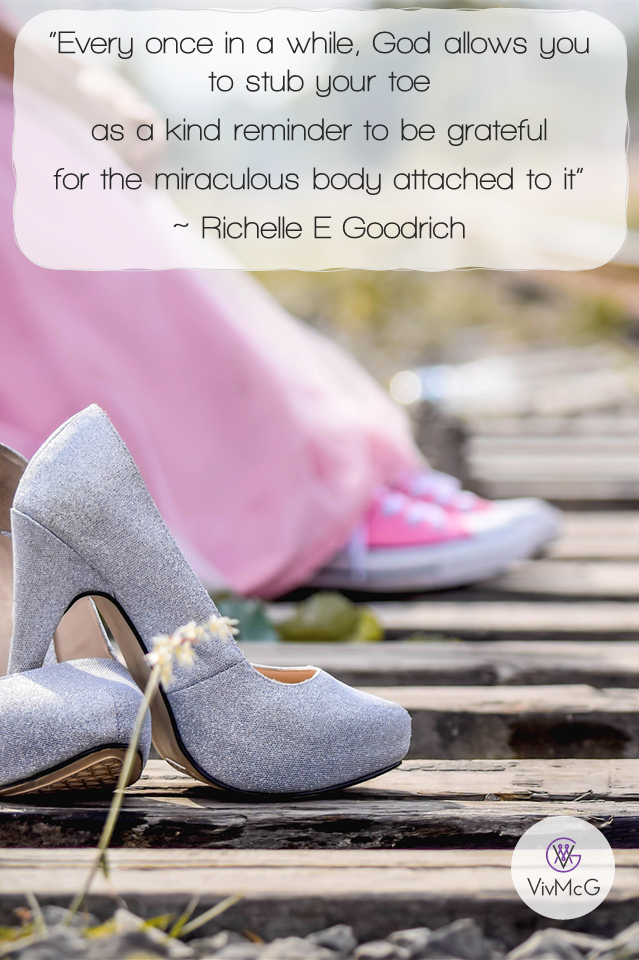
mobile
how to download your wallpaper
desktop
Before copying one of the pictures below, you'll want to quickly check your screen settings because the worst thing you can do is use a wallpaper with an aspect ratio that differs from the aspect ratio of your screen.
The aspect ratio of a rectangle is simply the proportion between width and height. The most common are 16:9, 16:10 and 4:3. And it will be for these 3 sizes that I shall provide you with your free wallpaper.
To find your screen resolution follow this basic guide. Steps for your computer may vary slightly but I hope this will give you some guidance:
- Right-click the desktop and select Display settings.
- Scroll down until you see "Resolution" (you may have to choose an "Advanced" option)
- To find your aspect ratio, divide the width over the height. For example, if my resolution is 1920 x 1080 then I would divide 1920 over 1080 to get 1.778, which indicates a 16:9 resolution. Similarly, 1.6 indicated 16:10 and 1.333 indicates 4:3
- When you've calculated your screen's aspect ratio, go to the picture below that matches that size
- Right click on the picture and select "Set as Desktop Background"
- Choose whether to "Fill", "Fit", or "Stretch" your picture - if you've chosen the right size "Fit" will be your best option
- Select "Set Desktop Background" and you're done
android mobile
- First, save the wallpaper image to your phone by pressing your finger on the wallpaper image and hold down on it until you see a menu.
- From here, click the “Save image” tab, and it will begin downloading.
- The next step is to set this saved image as your wallpaper by pressing and holding a blank area on your screen (meaning where no apps are placed), and home screen options will appear.
- Select 'add wallpaper' and choose whether the wallpaper is intended for 'Home screen', 'Lock screen', or 'Home and lock screen'.
- Another set of options will appear where you can choose where the photo you would like to use will be coming from, namely the Gallery.
- If necessary, crop the image to a suitable size. Once satisfied, simply click 'Done'.
ios smartphone
- First, save the wallpaper image to your phone by pressing your finger on the wallpaper image and hold down for about 2 seconds until a menu appears.
- From here, click “Save Image“, and it will begin downloading.
- The next step is to set this saved image as your wallpaper by, first, going to the 'Photos' app and selecting the wallpaper photo you've saved there.
- Click on the share icon on the lower left corner of the screen, then select 'Use as Wallpaper'.
- Then choose to set the photo as either the lock screen, home screen or both.

